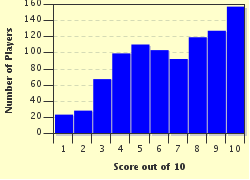Quiz Answer Key and Fun Facts
1. The two lines below were taken from a Number One song in 1940. A cover version came close in 1956 but it stalled at Number Two. What song was this?
"The wind in the willow played love's sweet melody
But all of those vows we made were never to be"
2. "When my life is through and the angels ask me to recall
The thrill of it all
Then I will tell them"
The next line revealed the song's title. It was a Number Nine hit for Jimmy Dorsey while Harry James took it to Number 24, both in 1942. In 1962, Frank Ifield carried it to Number Five on the Hot 100. It did even better in the U.K. where it topped the chart and was the biggest selling single record of the year. What was it?
3. In 1936, three versions of this song were top 10 hits. Benny Goodman, with Helen Ward handling the vocal, had the Number One hit. Then in 1957, a cover performed by Frankie Lymon and The Teenagers managed a Number 20 placement on the Hot 100. The lyric sample below was just slightly edited so as not to give the answer away. What song are we discussing?
"So you met someone who set you back on your heels
So you met someone and now you know how it feels
So you gave him your heart too, just as I gave mine to you
And he broke it in little pieces, now how do you do"
4. "_______, the dawn is breaking
_______, you'll soon be waking
To find your heart is aching
And tears will fall as you recall
The moon, in all its splendor
A kiss, so very tender
The words, will you surrender to me"
Fill in the blanks with one of the following girl's names and you have the title of a 1929 song written by Irving Berlin. A version by Rudy Vallee was the biggest hit of three charting versions that year, peaking at Number Two. Then Tommy Dorsey issued a recording with Jack Leonard as vocalist and it hit Number One in 1937! Finally, an Irish vocal trio named The Bachelors recorded it in 1965 and it climbed to Number 15. Which lady was it?
5. The movies have long been a source for hit songs and the following song is an example. Four different renditions charted in 1939 and they all were top ten hits. Glenn Miller's version topped the charts and the version sung by the star of the movie made it to Number Five. Giving you the name of that artist would be to give you the answer. A group called The Demensions had a Number 16 hit with their cover in 1960. Here's your lyrical clue, you deduce the right answer.
"Someday I'll wish upon a star
And wake up where the clouds are far behind me
Where troubles melt like lemon drops
Away above the chimney tops
That's where you'll find me"
6. "You may hear her laughing across a crowded room
And night after night, as strange as it seems
The sound of her laughter will sing in your dreams
Who can explain it, who can tell you why
Fools give you reasons, wise men never try"
This chestnut from stage and screen is another one of those that can't be disguised if you know music. So, I ask, from what musical did "Some Enchanted Evening" emanate?
7. A modest hit in 1924 and then again in 1961, I suspect this novelty song had people smiling on both sides of the pond both times. Here's one verse for a clue:
"Here comes the blushing bride, the groom is by her side
Up to the altar, just as steady as Gibraltar
The groom has got the ring and it's such a pretty thing
But as he slips it on her finger the choir begins to sing"
Now, on what unlikely topic did the church choir begin to sing?
8. The animated movie "Song of the South" contributed this Academy Award winning Johnny Mercer song to the charts in 1947.
"Mister bluebird on my shoulder
It's the truth, it's actual
Everything is satisfactual"
What song was it, covered by Bobb B. Soxx and the Blue Jeans in 1962?
9. Originally a Number Three hit for Vaughn Monroe in 1949, three competing versions vied for chart position on the Hot 100 when it made a comeback in 1965 with Vic Dana's version emerging on top at Number 10. The lines below should help in making the right choice. Can you name it?
"And if they do the trick, I'll hurry back to pick
Your best white orchid for her wedding gown"
10. A song written and recorded in 1902 is the oldest recorded song that I could find that had successful charting versions originally and during the rock era. Here's a small slice of the lyric.
"I'll do the cookin', honey, I'll pay the rent
I know I done you wrong"
Who is the object of this lament, the one who's been wronged?
Source: Author
maddogrick16
This quiz was reviewed by FunTrivia editor
agony before going online.
Any errors found in FunTrivia content are routinely corrected through our feedback system.

